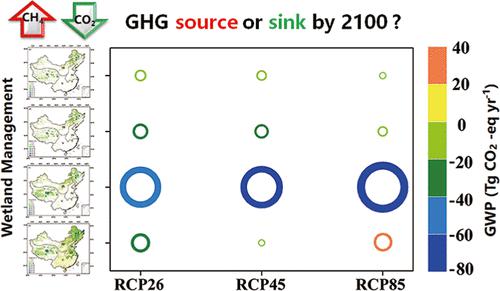当前位置:
X-MOL 学术
›
Environ. Sci. Technol.
›
论文详情
Our official English website, www.x-mol.net, welcomes your
feedback! (Note: you will need to create a separate account there.)
Methane Emissions from Wetlands in China and Their Climate Feedbacks in the 21st Century
Environmental Science & Technology ( IF 10.8 ) Pub Date : 2022-08-09 , DOI: 10.1021/acs.est.2c01575 Tingting Li 1, 2 , Josep G Canadell 3 , Xiu-Qun Yang 2, 4 , Panmao Zhai 5 , Qingchen Chao 6 , Yanyu Lu 7 , Danqing Huang 4 , Wenjuan Sun 8 , Zhangcai Qin 2, 9
Environmental Science & Technology ( IF 10.8 ) Pub Date : 2022-08-09 , DOI: 10.1021/acs.est.2c01575 Tingting Li 1, 2 , Josep G Canadell 3 , Xiu-Qun Yang 2, 4 , Panmao Zhai 5 , Qingchen Chao 6 , Yanyu Lu 7 , Danqing Huang 4 , Wenjuan Sun 8 , Zhangcai Qin 2, 9
Affiliation

|
Wetlands are large sinks of carbon dioxide (CO2) and sources of methane (CH4). Both fluxes can be altered by wetland management (e.g., restoration), leading to changes in the climate system. Here, we use multiple models to assess CH4 emissions and CO2 sequestration from the wetlands in China and the impacts on climate under three climate scenarios and four wetland management scenarios with various levels of wetland restoration in the 21st century. We find that wetland restoration leads to increased CH4 emissions with a national total of 0.32–11.31 Tg yr–1. These emissions induce an additional radiative forcing of 0.0005–0.0075 W m–2 yr–1 and global annual mean air temperature rise of 0.0003–0.0053 °C yr–1, across all future climate and management scenarios. However, wetland restoration also resulted in net CO2 sequestration, leading to a combined net greenhouse gas sink in all climate management scenarios, except in the highest restoration level combined with the hottest climate scenario. The highest climate cooling was achieved under medium restoration, with the climate scenario consistent with the Paris agreement target of below 2 °C, with a cumulative global warming potential of −3.2 Pg CO2-eq (2020–2100). Wetland restoration in the Qinghai–Tibet Plateau offers the greatest cooling effect.
更新日期:2022-08-09









































 京公网安备 11010802027423号
京公网安备 11010802027423号